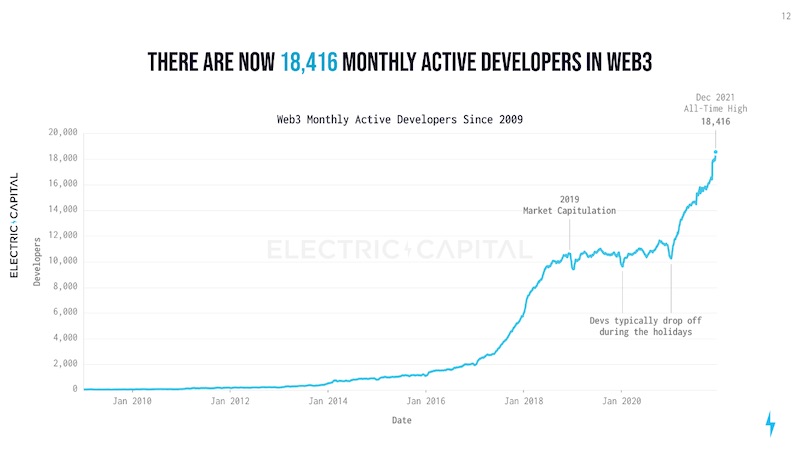In 2014, the cryptocurrency stage made room for a new star: Ethereum. Its co-founder, Gavin Wood, was the first person to coin the term ‘Web 3.0’. He segmented the history of the internet into three eras, asserting that our current era – ‘Web 2.0’ – required a level of trust in centralized platforms that was far too demanding and risky for the everyday user.
Instead, Wood was passionate about the idea of an internet where users and creators took full ownership of their digital assets, rather than handing them over to mega-corporations like Facebook and YouTube. Web 3.0 would be built on the blockchain; everyone could ensure the safety of their data and the ownership – and even monetization – of their creations.
In 2022, the Web 3.0 Wood spoke of is gaining more traction. There are already a number of decentralized social media apps accessible via blockchain technology. NFTs have exploded, and cryptocurrencies, albeit controversial and volatile, are as popular as ever.
What would all this mean for the world of recruiting? At one of our recent community events, we interviewed Elliott Garlock – Web3 Talent Strategist and Founder of Stella Talent Partners. He spoke about how Web3 companies can recruit and build their talent strategies in this competitive environment.
You can watch the interview below or scroll down to get a write-up of the key points.
Elliott's Background
Could you give us some background behind what you’re doing in this world of Web3 talent strategy, and how you got here? (0:37)
“I left Wayfair to work at Clear Street, which is a FinTech company. And we built that company up. And then everything was just getting so exciting in the Web3 space, so I decided that I wanted to get more involved in it.”
Elliott isn’t the only one noticing and responding to the appeals of the Web3 space. The industry has seen exponential growth in recent years; 2021 saw 18,000 plus active monthly developers committing code in Web3 projects, making up 65 percent of the total active developers in the space.

Other news coming to the surface indicates that tech giants like Apple and Google are already creating departments for Web3 development and innovation. This isn’t just a blip in the grand sea of tech ideas that will never come to fruition; it’s a real game-changer, and evidently, one that has caught the eye of independent developers and tech giants alike.
For Elliott, joining the Web3 space also meant freedom for his family and his career.
“I just wanted to have more freedom in my life. So I thought, ‘Okay, the market is sufficiently set up so that I can get involved in the Web3 space as a talent consultant and executive search professional. So I started this company a few months ago, and it's been quite a journey.”
What should we know about Web3?
Your thesis is that we're going to have a new internet in 10 to 15 years, and that Web3 is going to eat everything. For somebody who doesn’t know too much about what's going on, can you give us a succinct explanation of Web3?
In response to this question, Elliot explained that the internet economies happened in three phases: web one, web two, and Web3.
“Web1 was the beginning of the internet. There were static websites that were made by publishers. Users would go, and they would just read those static websites. That was all you could really do...for about a decade.”
In those early days of the internet, digital media was modeled on what we already knew; media is created, delivered, and consumed. There was no back-and-forth, as the technology to facilitate this had not been conceptualized nor created.
“Web2 started around 2006, and I would say that the most famous Web2 company is Facebook. Users started to create the content – so when you went on the internet, not only were you looking at what was on the internet, you were also creating things that were on the internet. And these centralized platforms made it very easy for people to become creators.”

The Web2 space blew up quickly, and it blew up exponentially. Hoards of creator-based websites began to flood every corner of the internet; we saw the likes of Reddit, Tumblr, Twitter, MySpace, and many of the platforms we still avidly use in 2022.
Elliott explained, however, that these platforms have a major downfall for creators – one that Web3 could help to resolve.
“Facebook owns Facebook. And if you have a profile page on Facebook, Facebook owns your profile page. YouTube owns your YouTube channel. But in Web3, you– the user– own the digital assets that are being created.”
This would land a tremendous blow to the current internet economy. Presently, we are the product; Facebook’s users are its commodity, which it then sells to advertisers. But all of that could change with the introduction of Web3.
“We're going to shift into an internet economy where, rather than having Google and Facebook and Amazon take most of the value that's been created and add that to their market caps, the wealth is going to be shared more broadly across the user base. The internet is going to become a much more open, much more participatory, much more democratic type of platform.”
Elliott's Career Path - Leading Up to Web3
What are some of the companies you've worked with? What are these employers actually doing in this space?
“In the Web3 industry there are all kinds of categories. One segment of it is the cryptocurrencies, which was the first application – a major one where there's still a lot of activity.”
Bitcoin was the first cryptocurrency available for trade and use, but of course, the range of currencies available via open blockchain has exploded since then. Another development to come from the success of cryptocurrency is the introduction of new blockchain applications.
“Many more applications are now being created. For example, NFTs is a category that has gotten a lot of attention in the last year and there are a bunch of different categories. It’s all based around owning your digital identity on the web.”
Elliot noted that there are a number of new uses emerging for NFTs. For example, Crypto Punk and Bored Ape Yacht Club are essentially digital social clubs that you get through purchasing NFT artworks.
Opportunities are also opening up for musicians to make money in the Web3 space. Rather than taking small royalties from mega platforms like Apple Music and Spotify, artists can sell portions of their music via an NFT project. As their work becomes popular and more people invest, they make money from the value of their token appreciation.
“There's a lot of enthusiasm around it. There are a tonne of startups that are looking at this particular idea. And I think it's very likely that in 10, or 15 years from today, you know, artists are going to reclaim ownership over their IP, and they're going to be sharing that ownership with their audience. And this is going to be a completely new thing that's never really existed before.”

Web3 Recruiting
What are the challenges of recruiting in this space?
“In Web3 recruiting, there are some unique challenges. The crypto-economy has been fringe for quite some time; it's only been in the last year that asset prices have pumped up. So there were a lot of people working in Web2 that were having serious FOMO.”
Elliott went on to explain a serendipitous phenomenon; the people who left Web2 companies like Facebook before it was ‘cool’ to join a volatile industry teeming with potential. They were the employees people considered irresponsible. However, many of them are now sitting on multi-million dollar nets due to the sudden lucrativeness of the Web3 space.
Now, many of the job hunters endeavoring to join the Web3 space are doing so in an attempt to catch the late train – and as such, Elliott pointed out that it can be difficult to tell who are the money-grabbers and who are truly passionate about their work.
“Now, you have all of these people who want to move in – but they're not moving in because they really care about the mission. They're just moving in because they want money. And generally speaking, people who are just purely motivated by greed are not going to do the best work.”
The problem is that there isn’t a wide enough pool of experienced Web3 people to go around, so those companies need to source talent from the Web2 pool. Vetting the greedy jobseekers from the genuinely interested ones can be a trying challenge.
Then, there is the issue of geographical spread.
“As Web3 companies start to get more successful, they have 30, 40, or 50 employees. But it's actually really hard to organize 40 people distributed across the world – and not all companies are like GitLab with super codified plans around how to run a disciplined remote organization.”

Working in the Web3 space is creatively demanding, and those in the industry would likely attest to the difficulty of completing this work whilst being spread across different time zones. Collaboration, feedback, and oversight all become monumental challenges.
Finally, there is the issue of money grubs; people trying to scam the industry and infiltrate the competition.
“Because there's so much money sloshing around, it attracts various scams. A group of North Korean spies actually interview for jobs at Web3 companies to get hired, infiltrate the company, and get a free paycheck while they're at it. I would say 20 percent of the candidates that come through our funnel for recruiter screens are these North Koreans.”
Why do companies get scammed by these fake recruits?
“Most of the Web3 companies don't have a guy like me who's running the talent department for the company. So you'll have a brilliant founder who's very busy... and these [scammers] kind of skate through. Because the crazy thing is, if you send these people the coding test, they will pass the coding test.”
Elliott explained that many companies are passionate about inclusivity and forward-thinking recruitment policies, and so they might hire someone based on their coding test even if the English-speaking efficiency isn’t there. The honorable intentions, however, are often met with unfortunate ends; scammers come through the company and steal their winning concepts.
This is where a company like Elliott’s can really save the day for Web3 companies. With thorough vetting in place, scams can be more readily avoided.
Advice for Web3 Recruiting
How are you finding talent in one of the most white-hot talent markets? How are you getting them through the funnel?
“If you look at the standard tech recruiting mix, one-third is referral, another third is inbound sourcing, inbound applicant, gender, generation, and review. And then one-third is outbound – going out and sourcing people. And I would say that those ratios are still broadly applicable to Web3.”
It was interesting to hear from Elliott that the Web3 talent pool is a small, tightly-connected community. This means that referral comes heavily into play.
“Because the community is really small, it's more tightly connected. So there's definitely a lot of referral hiring that I still see happening in the companies that I work with.”
Elliott also mentioned that, unlike other industries, hiring in the Web3 space doesn’t yet involve the use of incentives to get people on board.
“You don't really need to get clever with incentives or with tools when you're dealing with a 30, 40, or 50 person team. When you're small, everyone is much more connected and mission-driven – and it's a lot easier to get people involved in that.”
In the Web2 space, talent sourcing is often resume-based. Have you got an undergrad from Harvard? Did you go to MIT? Where have you worked, and what tech are you proven fluent in? For Web3, however, hiring is largely focused on proof of work.

“It’s very optics driven in Web3 because so much of the work is built using open-source software. Rather than looking at people's resumes, or their education, or their LinkedIn profiles, there's much more of a focus on people's actual work that's in the public domain. And the really good candidates always have it.”
What this means for job seekers in the Web3 space is a more level playing field. It has significantly less to do with what school someone can afford to attend, and everything to do with substance.
“If you really do have an interest in the industry, and you get involved in it, you will not be limited by whatever your education or previous employment is if your work is really good. It opens up access to people that wouldn't be able to get access in the more traditional tech economy.”
Web3 Recruiting Tools
What tools are you using to source those applicants?
“LinkedIn is still a great sourcing tool, but there's also activity that happens on the crypto dominant social platforms. Twitter, Discord, and Telegram are the three social platforms where there's a lot of crypto activity. So for proprietary sourcing and Web3, you definitely need a recruiter who's dialed into these communities and monitoring them.”
Perhaps one of the most interesting things about this recruitment space is that talented individuals will almost auction themselves off via Twitter or another platform. They will announce their departure from a current position and await a response or invitation from one of the Web3 recruiters.
“When these things pop, they happen really fast, which means you have to be constantly monitoring it. It’s a different way of doing candidate discovery than the way traditional tech recruiting typically works.”
Elliott went on to explain the importance of value props or things that attract talent to your company over another.
“Compensation is a big one, and then the credibility of the organization and how it's capitalized; who the team is, and what they're doing. Then there’s being consistent with the Web3 ethos of decentralizing, and having a plan to decentralize.”
When you’re not in the recruiting industry, it often seems as though the bulk of the challenge falls on the jobseekers; after all, they are the ones who must prove themselves as the best candidate out of tens, hundreds, and thousands of others. But in such a small talent pool, Web3 recruiters – like Elliott – are faced with the challenge of finding and securing the right people.
“At the end of the day, they're still human beings. And the thing that's most important to people is, ‘Who am I going to be with all day? Who's my manager going to be? Is that manager going to treat me with respect, be fair, allow me to develop my professional skills, and allow me to develop as a person?’ I think that's always going to be the most important thing to people.”

Advice for Web3 Employees
Are there any idiosyncratic things that candidates should be thinking about when they join these companies?
It’s important to remember that, for candidates looking to enter Web3 as employees, there are a number of traps that can be easily fallen into. It is crucial to understand the red flags in such a new and potentially volatile industry.
“As a candidate, it's very important that your company identifies a product-market fit in six to eighteen months. So one thing to really assess is, do the founder and team have good commercial heads on their shoulders and are they going to be able to quickly experiment and find a durable revenue model?”
In other words – if you want to get paid, and you want to join a company that lasts through the growing pains, you need to ensure that your potential employer can follow through with real value.
“A lot of Web3 companies are loaded up with money and ideas. But it's very important that you can turn those ideas into real value, and many of them are not going to be able to do that; they're going to run out of money, and they're not going to get refunded, and then they're going to be gone.”
Some, however, are far more commercially minded – and this is where we see the incredibly successful companies coming through to corner the market. The best way to join one of these teams is to assess the leadership; make sure the team is working on a solid and tangible revenue model.

Are there any final interesting things that you've come across in this space that you'd like to share?
“For people who do enter the industry over the next couple of years, I think the industry at large is going to go through a period of increased discipline, increased professionalization, and increased sensitivity. The value of execution is going to go up a lot.”
Unlike the growing population of Web3 skeptics, Elliott believes that Web3 is not far away from becoming our new normal – after a set of expected growing pains, of course. He predicts that those who follow their instincts into a Web3 role will be participating in the internet’s next evolutionary step.
“For people that want to enter this space, I think it will be less alien in two years than it is right now. It's going to become normal.”





















